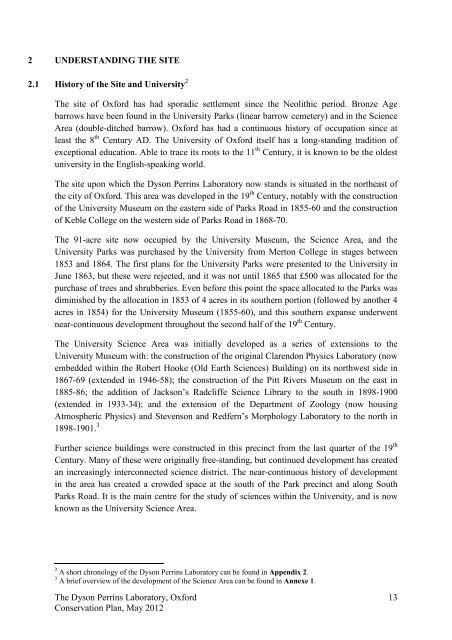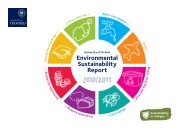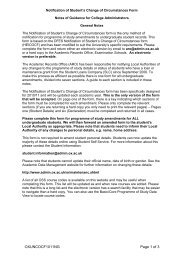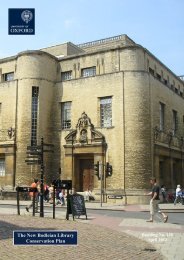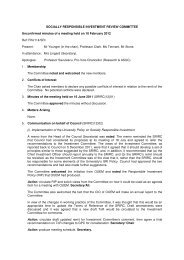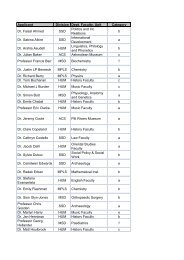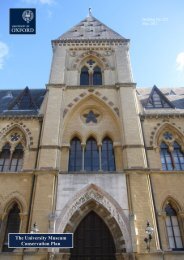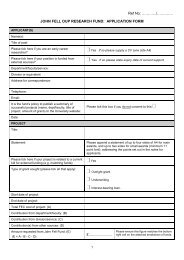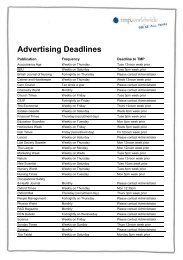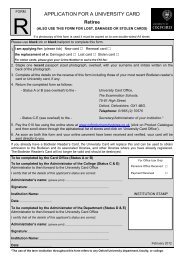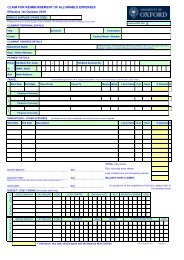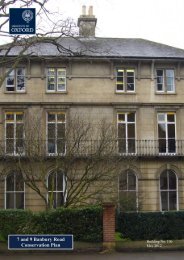Dyson Perrins Laboratory - Central Administration - University of ...
Dyson Perrins Laboratory - Central Administration - University of ...
Dyson Perrins Laboratory - Central Administration - University of ...
- No tags were found...
Create successful ePaper yourself
Turn your PDF publications into a flip-book with our unique Google optimized e-Paper software.
2 UNDERSTANDING THE SITE2.1 History <strong>of</strong> the Site and <strong>University</strong> 2The site <strong>of</strong> Oxford has had sporadic settlement since the Neolithic period. Bronze Agebarrows have been found in the <strong>University</strong> Parks (linear barrow cemetery) and in the ScienceArea (double-ditched barrow). Oxford has had a continuous history <strong>of</strong> occupation since atleast the 8 th Century AD. The <strong>University</strong> <strong>of</strong> Oxford itself has a long-standing tradition <strong>of</strong>exceptional education. Able to trace its roots to the 11 th Century, it is known to be the oldestuniversity in the English-speaking world.The site upon which the <strong>Dyson</strong> <strong>Perrins</strong> <strong>Laboratory</strong> now stands is situated in the northeast <strong>of</strong>the city <strong>of</strong> Oxford. This area was developed in the 19 th Century, notably with the construction<strong>of</strong> the <strong>University</strong> Museum on the eastern side <strong>of</strong> Parks Road in 1855-60 and the construction<strong>of</strong> Keble College on the western side <strong>of</strong> Parks Road in 1868-70.The 91-acre site now occupied by the <strong>University</strong> Museum, the Science Area, and the<strong>University</strong> Parks was purchased by the <strong>University</strong> from Merton College in stages between1853 and 1864. The first plans for the <strong>University</strong> Parks were presented to the <strong>University</strong> inJune 1863, but these were rejected, and it was not until 1865 that £500 was allocated for thepurchase <strong>of</strong> trees and shrubberies. Even before this point the space allocated to the Parks wasdiminished by the allocation in 1853 <strong>of</strong> 4 acres in its southern portion (followed by another 4acres in 1854) for the <strong>University</strong> Museum (1855-60), and this southern expanse underwentnear-continuous development throughout the second half <strong>of</strong> the 19 th Century.The <strong>University</strong> Science Area was initially developed as a series <strong>of</strong> extensions to the<strong>University</strong> Museum with: the construction <strong>of</strong> the original Clarendon Physics <strong>Laboratory</strong> (nowembedded within the Robert Hooke (Old Earth Sciences) Building) on its northwest side in1867-69 (extended in 1946-58); the construction <strong>of</strong> the Pitt Rivers Museum on the east in1885-86; the addition <strong>of</strong> Jackson’s Radcliffe Science Library to the south in 1898-1900(extended in 1933-34); and the extension <strong>of</strong> the Department <strong>of</strong> Zoology (now housingAtmospheric Physics) and Stevenson and Redfern’s Morphology <strong>Laboratory</strong> to the north in1898-1901. 3Further science buildings were constructed in this precinct from the last quarter <strong>of</strong> the 19 thCentury. Many <strong>of</strong> these were originally free-standing, but continued development has createdan increasingly interconnected science district. The near-continuous history <strong>of</strong> developmentin the area has created a crowded space at the south <strong>of</strong> the Park precinct and along SouthParks Road. It is the main centre for the study <strong>of</strong> sciences within the <strong>University</strong>, and is nowknown as the <strong>University</strong> Science Area.2 A short chronology <strong>of</strong> the <strong>Dyson</strong> <strong>Perrins</strong> <strong>Laboratory</strong> can be found in Appendix 2.3 A brief overview <strong>of</strong> the development <strong>of</strong> the Science Area can be found in Annexe 1.The <strong>Dyson</strong> <strong>Perrins</strong> <strong>Laboratory</strong>, Oxford 13Conservation Plan, May 2012


